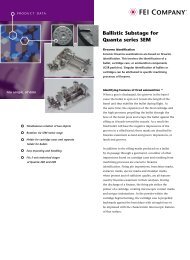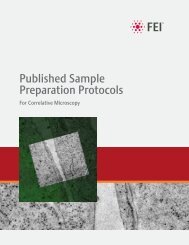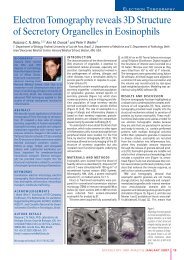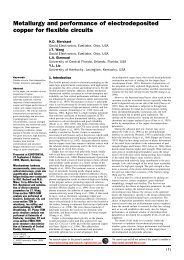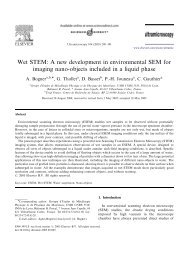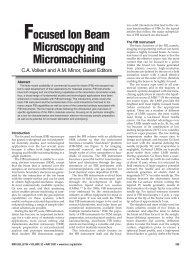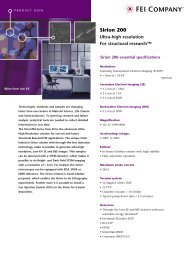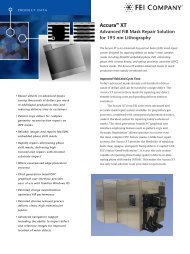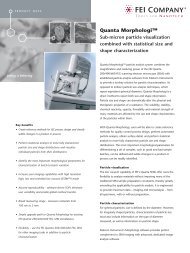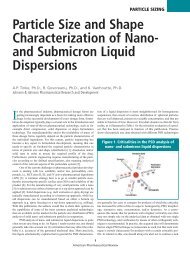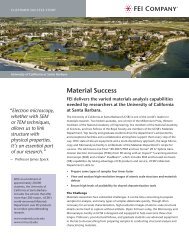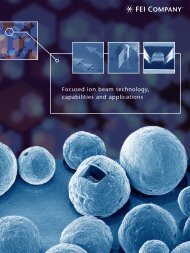TEM Sample Preparation Tips - FEI Company
TEM Sample Preparation Tips - FEI Company
TEM Sample Preparation Tips - FEI Company
Create successful ePaper yourself
Turn your PDF publications into a flip-book with our unique Google optimized e-Paper software.
<strong>TEM</strong> <strong>Sample</strong> <strong>Preparation</strong> <strong>Tips</strong><br />
Brennan L. Peterson, Ph.D., Process/Applications Development<br />
When preparing samples for the<br />
transmission electron microscope<br />
(<strong>TEM</strong>), obtaining samples of uniform<br />
thinness (from 10–200 nm) is critical.<br />
There are a few different sample<br />
geometries, the most common of which<br />
is thin foils, or lamellae.<br />
A broad literature exists on the exact<br />
methods and some of the tradeoffs<br />
around creating lamellae. Mayer,<br />
Giannuzi, et al. (2007, MRS Bulletin)<br />
detail many of the more intricate<br />
decisions. Extensive literature and application notes exist, and it is not the goal<br />
of this work to describe this literature in detail.<br />
Rather than a detailed primer on step-by-step lamella creation, this document<br />
offers an overview of tips, tricks, and standards for the advanced practitioner.<br />
Some critical requirements and restrictions on <strong>TEM</strong> preparation are:<br />
• Positioning accuracy<br />
• Lamella thickness<br />
• <strong>Preparation</strong> speed<br />
• The amount of amorphous material left from the FIB process<br />
• Removal and placing on <strong>TEM</strong> grid<br />
• Tools setup<br />
Focused ion beam (FIB) methods are generally faster than manual preparation,<br />
with exceedingly high placement accuracy. Using the best methods and tools,<br />
placement accuracy of
interface effects. For S/<strong>TEM</strong>s (scanning/transmission electron microscopes), this<br />
requirement is somewhat relaxed, but sample restrictions often result in the<br />
need for
it is a good rule of thumb to target no less than five seconds for a mill, and to<br />
target beam size using the largest appropriate aperture.<br />
A typical recipe or program uses 13 nA for bulk milling and undercutting, 1<br />
nA for medium thinning, 30–100 pA for fine milling, and 3kV–120 pA (using<br />
1000pA aperture) for final cleaning. Variations (3 nA instead of 1 nA for medium<br />
thinning) are possible, depending on user preference and the details of the<br />
available aperture strip.<br />
For the timings listed above, fully automated processing in arrays should use<br />
the lowest timings and skip the endpointing stop. This results in ~20 minute<br />
preparation times. Faster is possible, again depending on the exact application<br />
and targets.<br />
Positioning accuracy<br />
The position of the <strong>TEM</strong> lamella is critical to<br />
find an isolated feature, or to fully encapsulate a<br />
reference feature (for instance, a row of contacts).<br />
In cases where only a single feature in an array is<br />
needed, the lamella can easily be prepared at a<br />
slight angle to the feature.<br />
With FIB systems, the lamella can be positioned relatively accurately within<br />
the instrument’s mean drift (including both sample drift, due to imaging or<br />
charging, and stage drift).<br />
Through fiducials can be used to improve location of a particular feature during<br />
cross-sectioning. During final thinning, the user can thin until the precut (and<br />
filled) fiducials are seen in a cross-section image. These lines are usually milled<br />
at ~100 nm width, which forms a good basis for judging final thickness. To form<br />
these sorts of through fiducials, small (
With dual-beam systems, the SEM or S/<strong>TEM</strong> (scanning transmission electron<br />
microscope) can be used to improve the registration by stopping the thinning at<br />
a particular image location. Without a dual beam for final location, the measured<br />
accuracy is on the order of 50 nm (3 sigma) for top-down FIB-prepared systems.<br />
Refinement in a small dual beam can allow a practiced operator nm-level<br />
placement.<br />
To measure placement accuracy, there are a few different metrics: the placement<br />
of the fiducial relative to the feature, as well as the placement of the final lamella<br />
as compared to the initial fiducial. Overall placement can also be judged by<br />
measuring the final placement of a known reference feature within a lamella.<br />
Lamella thickness<br />
Lamella thickness is critical for accurate <strong>TEM</strong> metrology, and to a lesser extent,<br />
for S/<strong>TEM</strong> imaging. In transmission techniques, analysis is greatly simplified for<br />
single scattering events. In addition, the sample attenuates the beam. Roughly<br />
speaking, S/<strong>TEM</strong> samples generally target approximately 80 nm. For <strong>TEM</strong>,<br />
samples generally range from 20–80nm, depending on the specific sample and<br />
<strong>TEM</strong> tool.<br />
Thickness is usually measured either by cross-sectioning the thin lamella, or by<br />
measuring the electron beam attenuation (this requires an accurate calibration<br />
standard). Quoted values in 1/e lengths center roughly on 100 nm +/- 20%.<br />
Figure 4 – Cut placement<br />
measurement via cross-section<br />
of a line.<br />
<strong>TEM</strong> <strong>Sample</strong> Prep
Top-down measurement of <strong>TEM</strong> sample thickness is heavily influenced by the<br />
protective overcoat, and is only approximately accurate (30%). For accurate and<br />
reliable measurement, cross-sections of lamella (see Figure 5) are much more<br />
accurate and useful.<br />
Uniformity of thickness is also important, although sometimes samples are<br />
intentionally made with varying thickness. This can simplify preparation (it is<br />
easy to make a wedge, vastly harder to make a uniform 10 nm sample) but must<br />
be taken into account when interpreting data.<br />
<strong>Preparation</strong> speed<br />
For large-scale lab implementation, preparation speed is a useful quantifier of<br />
the process. However, <strong>TEM</strong> preparation speed varies depending on the nature<br />
of the sample. In particular, overall preparation time is affected by how long<br />
it takes to remove the sample and find the area of interest. Depending on the<br />
exact use case and desired thickness, different preparation speeds are possible.<br />
To measure preparation speed, it is important to specify and understand the<br />
removal method (plucking with a glass rod is fast, in situ transfer to a <strong>TEM</strong> grid<br />
is slow) as well as any special conditions necessary for preparation.<br />
Table 2 shows a breakdown of preparation times. More details can be found<br />
in Table 1. Because preparation needs differ dramatically between sites, these<br />
times offer at best a guide.<br />
It is worth noting the significant differences between the different preparation<br />
times. The most fundamental difficulty and time-determining step is site-specificity.<br />
Figure 5 – 1) Top-down<br />
measurements. 2) Heuristic<br />
protective cap measurements.<br />
3) Cross-sectional<br />
measurements (most accurate).<br />
<strong>TEM</strong> <strong>Sample</strong> Prep
The fundamental rate limit is easily calculated. To carefully mill and image takes<br />
~15 seconds per step. These mill steps need to be ~2–5 nm. If placement is within<br />
50 nm and a bit of safety margin is added, between 10 and 30 minutes of milling<br />
will be needed per side to locate a feature.<br />
This is much more important when the features (as in post-package defect<br />
analysis) are not easily visible top-down. In this case, as much as 2 microns<br />
of material may need to be investigated. This can easily require 2–3 hours of<br />
dedicated searching for defects in cross-section. Cut placement really is key,<br />
and it is critical to place the initial cross-section of lamella accurately in order to<br />
maximize productivity.<br />
<strong>Preparation</strong> type<br />
Non-location specific<br />
Electrical defect<br />
(isolate)<br />
Site-specific<br />
4 hours, depending on<br />
difficulty in defect location<br />
~1-2 hours<br />
2 additional hours, increased<br />
failure rates<br />
Table 2 – Approximate times<br />
for different preparation types.<br />
Note the wide gaps in potential<br />
preparation times.<br />
<strong>TEM</strong> <strong>Sample</strong> Prep
For perspective, a 50 nm sample will be almost completely amorphized by a<br />
normal 30 kV beam (20 nm per side). With the FIB used to clean the sample at<br />
5 kV, this is reduced to 5 nm of total damage (or 10%). For 2 kV cleaning, this<br />
is further reduced to ~2 nm. See extensive work by Mayer, Gianuzzi, et al. (MRS<br />
Bulletin 2007).<br />
For reference, compare Figure 6, which shows the effects of 5 kV deposition and<br />
SEM deposition (SEM leaves no damage). This is a proxy for in-plane damage to<br />
a FIB sample, not a direct image. It does show the same key effects—namely,<br />
that the FIB does damage surfaces and interfaces, which is one of the key<br />
challenges in sample preparation.<br />
FIB damage/<br />
amorphization<br />
To compare success, it’s useful to use the <strong>TEM</strong>’s capability to look at the silicon<br />
“dumbbell.” This feature is fairly indicative of both good <strong>TEM</strong> alignment and<br />
good preparation. If the sample is prepared well, the Si dumbbell is easily visible<br />
in a <strong>TEM</strong> with
At <strong>FEI</strong>, we use different automated preparation methods depending on the<br />
system in use.<br />
Tool setup<br />
• Auto<strong>TEM</strong> uses the AutoFIB scripting system on Windows XP and XT<br />
software systems.<br />
• Auto<strong>TEM</strong> G2 is a simplified script-based system on Windows XT tools<br />
(Helios and Strata families), which is targeted at simple installation<br />
and application.<br />
• IC3D is used on Certus/CLM tools, and is an alternate scripting<br />
system aimed at very high volume use (over 50 lamellae per day,<br />
with potential of four per hour).<br />
One critical and often ignored component of good lamella preparation is<br />
accurate tool setup. Over the course of a four-hour lamella preparation, it is<br />
typical to spend 15 minutes or more refocusing and stigmating beams.<br />
In <strong>TEM</strong> preparation, here are a few things that can make this simpler:<br />
•<br />
•<br />
•<br />
Capacitance probe systems can automatically and accurately<br />
reset height. This keeps the FIB in focus at all times.<br />
Set up the tool at the FIB’s eucentric point. Tilt stage systems<br />
have an option to set the eucentric point based on the<br />
coincident point, the FIB’s eucentric, or the SEM’s eucentric.<br />
<strong>TEM</strong> preparation is helped dramatically by setting the tool<br />
according to the FIB’s eucentric point. This avoids beam shift<br />
and motion during sample preparation.<br />
Maintain tools well. It is imperative to make sure beams are<br />
well set. Less than nm variation in results is only possible<br />
if tools are kept in shape. Automated maintenance/PM<br />
routines are very useful in this regard—particularly FIB focus,<br />
stigmation, and beam coincidence.<br />
<strong>Sample</strong> transfer and storage<br />
<strong>Sample</strong> transfer mechanisms fall into two general types: the in situ autoprobe,<br />
and ex situ plucking with a glass rod. Each method has benefits, depending on<br />
the application target. Ex situ liftout is typically significantly faster.<br />
<strong>TEM</strong> <strong>Sample</strong> Prep
Endpointing<br />
Endpointing in <strong>TEM</strong> preparation<br />
typically uses the SEM signal to look<br />
at either secondary or backscattered<br />
electrons from a sample, and<br />
correlates these to thickness. The<br />
easiest method is simply to use the<br />
brightness: very thin samples become<br />
either dark or bright (depending on<br />
detector layout and source) once<br />
thinned past ~100 nm. The exact<br />
value depends on the beam energy<br />
and imaging mode.<br />
Similar techniques can be used with the integrated S/<strong>TEM</strong> detector system,<br />
with the added advantage of enhanced resolution over SEM-based techniques.<br />
The S/<strong>TEM</strong> system allows direct thickness measurements to be made from first<br />
principles, or contrast differential techniques can be used in darkfield.<br />
Conclusion<br />
Following these tips and tricks can greatly enhance productivity in <strong>TEM</strong> sample<br />
preparation by helping you achieve critical uniform thickness. For more on these<br />
methods and other helpful information from <strong>FEI</strong>, visit http://wiki.fei.com.<br />
References<br />
Mayer et al. 00 . <strong>TEM</strong> <strong>Sample</strong> <strong>Preparation</strong> and FIB Induced Damage. MRS Bulletin 0 V .<br />
© 5/2008<br />
0 WP-TE0111<br />
<strong>FEI</strong> <strong>Company</strong><br />
World Headquarters and<br />
North American Sales<br />
0 NE Dawson Creek Drive<br />
Hillsboro, OR 1 - USA<br />
Tel: +1 0 00<br />
Fax: +1 0 1<br />
fei.com/sales<br />
European Sales<br />
Tel: + 1 0<br />
Fax: + 1 0<br />
110<br />
Asia-Pacific Sales<br />
Tel: + 1 1<br />
Fax: + 1 1<br />
Japan Sales<br />
Tel: + 1 0 0 0<br />
Fax: + 1 0 0<br />
Figure 7 – Glass rod plucking of<br />
samples.<br />
<strong>TEM</strong> <strong>Sample</strong> Prep



